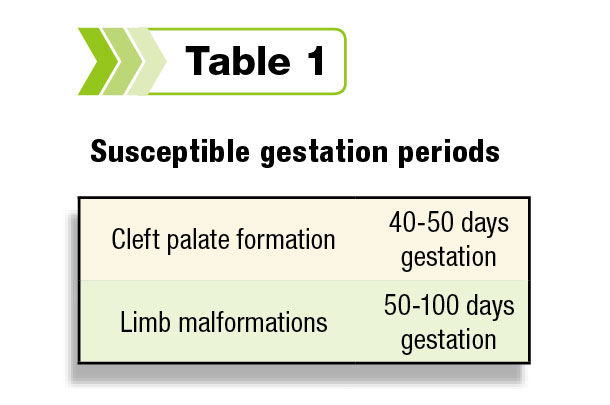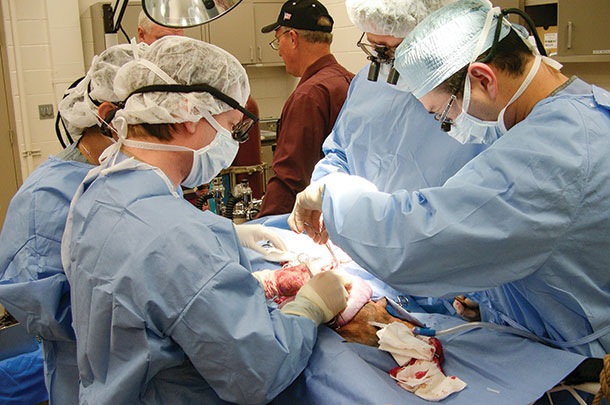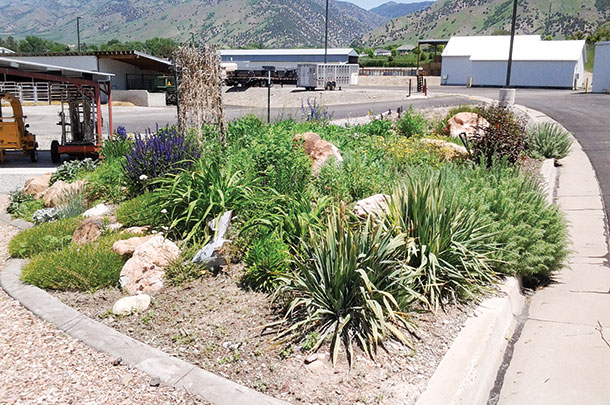The Poisonous Plant Research Lab’s raison d’etre is to provide livestock producers, whose animals graze on the ranges of the 17 Western states, with management plans that prevent or reduce the loss of animals that ingest a toxic dose from a multitude of wild plants. The facility is operated under the auspices of the Agricultural Research Service in the USDA.
The chance reading in 1992 by Dr. Jeffrey Weinzweig, a plastic surgeon, of a research paper from the PPRL has led to the translation of plant and animal science discoveries that one day could eliminate numerous surgeries over several years for a child born with a cleft palate and its concomitant facial disfigurement.
“Our mission – we understand what it is,” says Kip Panter, research leader at PPRL since 2007 and co-author of the 1992 paper. A toxicologist of 40 years’ experience, Panter oversees the work of 10 scientists plus 20 support staff and students at the only facility of its kind in the U.S. While the lab focuses on the Western states, its mission is to serve the entire country, Panter says.
The PPRL mission and a 116-page booklet for producers
Poisoning by plants results in more than $500 million of direct losses annually to the livestock industry in the 17 Western states. Direct losses include death and abortions. Economic losses are actually much greater when lost grazing opportunities, management adjustment, lost production, delayed or failed reproduction and culling costs are factored in.
The mission of the USDA-ARS Poisonous Plant Research Lab in Logan, Utah, is to identify conditions of poisoning, characterize the toxins in plants poisonous to livestock, define toxicosis and mechanisms of action, determine metabolism and toxin clearance from tissues, develop diagnostic and prognostic procedures, develop management strategies, and make recommendations to reduce losses.
The PPRL brings a multiple interdisciplinary approach to investigate each poisonous plant which begins with plant identification (taxonomy) and proceeds through identification of the toxin (chemistry) to understanding how and why poisoning occurs (physiology, toxicology, molecular biology, animal science) to providing diagnostic tools (pathology) and treatments (veterinary medicine) or management recommendations (range science) to mitigate losses.
Available from the lab is a 116-page booklet, reprinted in 2014, which describes more than 40 of the principal poisonous plants growing on Western ranges and the signs of poisoning in livestock. Management recommendations are included to help mitigate livestock poisoning by plants.
Poisonous Plants is available online.
A key mission
The underlying principle for Panter and his team is, “The toxin is in the dose,” he says. “How fast and how much of which plants” are ingested are the baseline from which they operate. Unlimited information about poisonous plants and management options for livestock producers are available from the lab, which was set up in 1955 in Logan, Utah, using World War II “tin huts.”
Forerunners of the lab’s services were USDA field stations initiated in 1905. A new lab was constructed in 2004. It is adjacent to the university campus. It provides lectures and studies to range and animal science classes and the veterinary school.
Indicative of the role the lab plays is illustrated by a “catastrophic” outbreak of lupine-induced crooked calf syndrome in central Washington state in 1997, Panter says. “Four thousand calves were affected by the lupine ingestion by the mother cows,” he says. “Some (producers) lost an entire calf crop.”
The interdisciplinary research by the PPRL was able to determine the toxin involved and the susceptible gestation periods that led to the limb and, on occasion, mouth deformations (Table 1). 
There are more than 300 species of lupine in North and South America. Plant maturity varies from region to region and depends heavily on environmental conditions, a major factor in years when lupine-induced crooked calf syndrome caused the large losses to the cattle industry in the western U.S. The toxin anagyrine, discovered by the late Richard Keeler, a PPRL chemist, was determined to be the alkaloid that caused the birth defects.
Recent studies have shown cattle graze lupines more readily when grasses become mature, dry and less available. Once grasses are less available, cattle rely on forbs and shrubs for nutrients. Ironically, lupine is very nutritious, containing up to 18 percent protein in its vegetative parts and 20 to 40 percent in the seeds, which is where the toxin is most concentrated. Specific grazing management strategies for lupine are available in pamphlet form from the lab.
Lupine grazing management strategies
Poisoning can be reduced by keeping hungry animals away from lupine in the early growth stage, in late summer when the plant is in the highly toxic seed stage, and from dense plant stands at all times. Risk of lupine-induced crooked calf disease can be reduced by applying the following management recommendations to individual ranch circumstances.
1. Identify lupine species on your ranch. (Universities and extension offices can help with plant ID.)
2. Determine the alkaloid profile and relative risk. (PPRL will analyze at no cost.)
3. Alter breeding schedules. Fall calving often prevents crooked calf disease.
4. Use intermittent grazing schedules by moving cattle to lupine-free pastures when lupine ingestion begins and returning after seed shatter.
5. Identify “lupine eaters” and cull those cows or keep them on lupine-free pastures during 40- to 100 days’ gestation.
6. Graze yearlings or open cows on lupine pastures.

The human side
An exciting part of the research at the PPRL lies in translating animal research to humans, Panter says. The work of Panter and his staff in diagnosing the cause of lupine-induced cleft palate culminated in 2008.
A female Spanish goat pregnant with three kids, each with induced cleft palates, were taken to Boston where Weinzweig, then head of plastic and reconstructive surgery at Lehey Medical Clinic in Burlington, Massachusetts, and a surgical team repaired in utero the cleft palates of two of the three kids.
At birth, the two repaired kids had normal palates, while the control kid died within a few days from pneumonia, Panter describes. Subsequent surgeries were done in Logan.
Funding is being sought from the FDA for further studies on this microscopic surgical procedure, Panter says, and could someday be used on human fetuses.
Gene markers are also as important in humans as in livestock, and the benefits for pregnant women are great, Panter says. “We understand what our mission is,” he says. “But the spin-off benefits, we get these for very little extra cost.
“The gene marker work that Ben (Green) is doing has direct relevance to the fetal movement mechanism associated with this cause of cleft palate as well as the means to select cattle for resistance to multiple plant poisoning involving a neuromuscular mechanism,” Panter says.
Green, a pharmacologist, says he is looking for genetically transferable traits in cattle that would show which animals are susceptible or resistant to specific toxins. “The real challenge now is to get the number of animals needed for the studies,” he says.
Each year, the lab buys 12 to 15 Line 1 Hereford steers from the Fort Keogh Livestock and Range Research Laboratory near Miles City, Montana, as genetic controls for baseline comparisons. Line 1 Herefords are known for their genetic purity. 
Livestock solutions
The lab’s essential work is to provide solutions to livestock producers. The example used by Panter was the discovery of gestational sensitivity in sheep to skunk cabbage. Researchers were directed to the plant by Basque sheepherders who suspected the plant caused the deformity known as “monkey-faced” lambs – analogous to lupine and the crooked calf and cleft palate results in cattle and goats. The researchers found that if pregnant ewes consumed skunk cabbage on the 14th day of gestation, it resulted in the deformity.
“Such (precise) plant gestation sensitivity leads to changes in breeding and feeding routines,” Panter says.
The lab provides in-depth management plans for keeping livestock safe while grazing. It has produced a 24-page producer’s handbook for decision-making on ranges with tall larkspur, a poisonous plant present in Idaho, Montana, Wyoming, Nevada, Utah and Colorado.
These plans begin with the identification of the poison and how much is in the plants. Chemist Dale Gardner has spent the past 24 years teasing out the toxins and measuring their toxicity. He is one of six scientists who produced the larkspur handbook. His current research is focused on the two forms of the toxin, swainsonine, in locoweed which is harmful to horses, cattle and sheep.
The PPRL maintains an internationally accredited poison plant herbarium of more than 5,000 species, according to Panter.
Other major problems of concern to livestock graziers include the effects of Ponderosa pine needles, which cause spontaneous abortion in cattle; selenium, a naturally occurring essential micro-nutrient that can result in toxic doses in horses, cattle, sheep and goats; and the restoration of beneficial grasses on the scablands of eastern Washington state. Scablands were created by prehistoric floods at the end of the last Ice Age more than 15,000 years ago.
Molecular biologist Zane Davis is at work on selenium poisoning. The element has a cumulative effect in certain range plants. Davis’ research is a contest of “efficiency versus toxicity,” he says, as there is a quite narrow safety margin between the two.
Again, management plans and recommendations are readily available from the lab. “It is a resolution to the problem for producers,” Panter concludes. ![]()
Click here to access the website of the Poisonous Plant Research Lab.
Jim Gransbery, a former agricultural reporter for The Billings (Montana) Gazette, is a freelance writer living in Billings.
PHOTO 1: Photo is a yearling steer the rancher salvaged for home use. The birth defect is the result of its mother eating lupine during the second trimester of pregnancy. Photo courtesy of Kip Panter.
PHOTO 2: Surgeons performing in utero fetal cleft palate repair in a goat model. Photo courtesy of Kip Panter.
PHOTO 3: Poisonous Plant Research Lab’s garden of plants that are toxic to animals grazing in pastures/range where these plants are available for consumption. Photo courtesy of PPRL.







